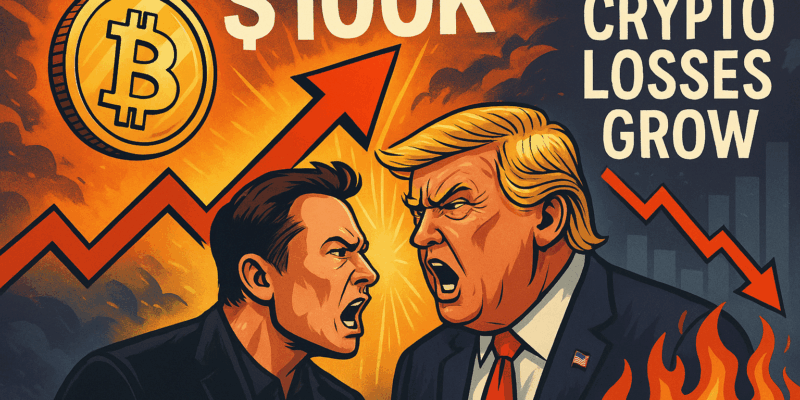Bitcoin Threatens $100K, Crypto Losses Grow as Musk/Trump Feud Goes Nuclear
Introduction
The cryptocurrency market has once again taken center stage as Bitcoin resumes its upward trajectory, mounting a bold march toward the symbolic $100,000 level. Investors, traders, and financial institutions alike are watching closely as mounting macroeconomic pressures and growing institutional interest propel the world’s most recognized digital asset to new heights. While long-term holders or “hodlers” celebrate this bullish momentum, the industry is simultaneously dealing with headline distractions, including a heated dispute between tech titan Elon Musk and former U.S. President Donald Trump. This bizarre feud has stirred the pot in crypto Twitter and mainstream media, stirring short-term fear and volatility within the broader investment community.
Despite the media noise, many experts and seasoned investors retain confidence in the fundamentals driving this new phase of growth. Bitcoin is no longer just a speculative asset for early adopters; it is increasingly being regarded as a serious hedge against inflation, sovereign risk, and monetary mismanagement. The convergence of institutional capital, structural economic weaknesses in legacy financial systems, and the rising awareness of blockchain technology is breaching a historical inflection point. We’re entering a new paradigm of digital finance—one in which Bitcoin at $100,000 may soon feel normal, not extraordinary.
Bitcoin’s $100K Trajectory: What’s Fueling the Surge
Bitcoin’s dramatic rise toward six figures is not a matter of coincidence or sudden investor mania. Instead, it is the result of multiple reinforcing dynamics converging all at once. One of the most compelling forces behind this move is institutional accumulation. Major financial institutions like BlackRock, Fidelity, and even conservative sovereign wealth funds are diversifying into Bitcoin, signaling a tectonic shift in the way capital allocators perceive digital assets. These institutions bring credibility, regulation, and billions—if not trillions—of dollars into the ecosystem, effectively anchoring Bitcoin’s perception as a legitimate asset class.
This deepening interest stems from growing disillusionment with the current fiat financial system. Governments around the world, particularly in the West, are grappling with soaring debt-to-GDP ratios, sluggish economic growth, and persistent inflation. Traditional monetary policy tools appear increasingly ineffective, triggering concerns over currency debasement and the long-term viability of fiat currencies. In contrast, Bitcoin’s fixed supply of 21 million coins, decentralized network architecture, and transparent monetary policy make it an appealing alternative to traditional stores of value.
Retail investors follow closely behind. As institutional legitimacy increases, average users are gaining the confidence to buy and hold Bitcoin, trusting its long-term potential. Social media, financial influencers, and a broader base of crypto educators are helping demystify digital assets, lowering the barrier to entry for everyday participants. This creates a flywheel of demand: institutions enter the market, retail follows, price rises, media coverage grows, and the cycle continues.
Further contributing to Bitcoin’s bullish momentum are on-chain metrics. Wallet addresses holding more than 1 BTC are rising steadily, miner outflows to exchanges are decreasing—implying long-term holding intent—and transaction volumes remain healthy across key networks. If you’re looking for a deeper dive into technical data and economic projections, our latest Bitcoin Price Prediction offers comprehensive insights into what lies ahead.
The Musk/Trump Feud: Market Noise or Signal?
The recent public clash between Elon Musk and Donald Trump has added a dose of unpredictability to the market, stirring conversation and temporarily rattling confidence, particularly among retail investors. Musk, a long-time supporter of Dogecoin and fairly open to crypto discussions, has found himself at odds with Trump’s vocal anti-crypto sentiment. Trump has long criticized Bitcoin, calling it a “scam” and suggesting that it threatens the dominance of the U.S. Dollar.
While these exchanges may capture headlines and generate meme-worthy social media responses, they offer little in terms of fundamental impact. Smart investors recognize this drama for what it is—short-term noise that doesn’t alter the long-term value proposition of decentralized assets. On the contrary, these distractions can provide unexpected trading opportunities. Political skirmishes tend to introduce fear, uncertainty, and doubt (FUD) into the market, leading to brief sell-offs that can benefit savvy participants who are prepared to “buy the dip.”
For those adopting a Contrarian Investor mindset, moments like these serve as powerful accumulation opportunities. History has shown time and again that emotional market reactions are often overblown. When headlines eclipse fundamentals, disciplined investors quietly load up on high-quality assets like Bitcoin and Ethereum. Understanding the distinction between noise and signal is critical in navigating this high-volatility space.
One could even argue that such confrontations further validate the disruptive nature of cryptocurrencies. If powerful figures are publicly addressing—or attacking—digital assets, it illustrates that these technologies are no longer fringe topics. They are now integral to the broader political, economic, and ideological discussions shaping the modern world.
Strategies for Navigating Crypto Chaos
As we move through cycles of euphoria and fear, it’s essential to employ a structured, data-driven approach to crypto investing. The following strategies can help build resilience in your portfolio and position you for long-term success in an increasingly chaotic environment:
- Leverage a Tiered Accumulation Strategy: One of the most effective tools to mitigate volatility is Dollar-Cost Averaging (DCA). This method involves allocating a fixed dollar amount at regular intervals—regardless of price movements. By doing so, you reduce emotional attachment to short-term swings and systematically build exposure over time. You can also apply a tiered DCA approach, increasing position sizes during major dips and dialing back during rally phases.
- Reassess Portfolio Allocations Periodically: With Bitcoin leading a potential breakout, smaller-cap altcoins—particularly those contributing to decentralized finance (DeFi), real-world asset tokenization, or AI-crypto convergence—offer asymmetric opportunity. Periodically reviewing and rebalancing your portfolio can help capture value in emerging narratives without overexposing you to unnecessary risk.
- Focus on Analytics, Not Algorithms: Combat hype-driven speculation by anchoring your decisions in measurable, verifiable data. On-chain analytics tools like Glassnode or CryptoQuant offer insights into exchange reserves, wallet activity, miner flows, and network health. These metrics provide a more reliable picture of market sentiment and long-term trends than social platforms or influencer commentary.
- Strengthen Risk Management Protocols: In a market prone to black swan events, having stop-losses, capital preservation rules, and a well-defined exit plan are essential. Allocate only what you can afford to lose, and diversify across market caps, sectors, and ecosystems.
- Stay Informed and Curious: Volatility is a feature, not a bug. Educate yourself consistently. Follow trusted analysts, utilize decentralized information sources like newsletters, forums, and expert interviews. Staying informed puts you one step ahead of the herd, allowing you to act rationally while others react emotionally.
Successfully navigating the crypto market requires mental fortitude, strategic execution, and a long-term perspective. Volatility is the price of admission—but with the right approach, it can also be the engine of immense wealth creation.
Conclusion
The Bitcoin rally toward $100,000 is not just a fleeting speculative dream. It symbolizes a global shift in monetary consciousness. Central banks, governments, critical institutions, and everyday users are all facing the same question: is the existing financial system sustainable? For an ever-growing number of users, the answer is “no”—and Bitcoin offers a compelling alternative.
As political sideshows involving high-profile figures such as Musk and Trump steal headlines, the real action is occurring beneath the surface. Institutional strategies are evolving. Economic policies are being scrutinized. On-chain data continues to reflect rising adoption and declining willingness to part with hard-earned satoshis. The trajectory isn’t linear, and corrections will come—but the long-term direction seems increasingly inevitable.
Whether you’re a veteran crypto whale or a newly onboarding Crypto Investor, now is the time to enhance your conviction, refine your strategy, and resist the urge to be swayed by temporary narratives. The digital asset revolution is accelerating—and those who maintain their focus on fundamentals may find themselves well-rewarded as digital finance reshapes the global economic order.













